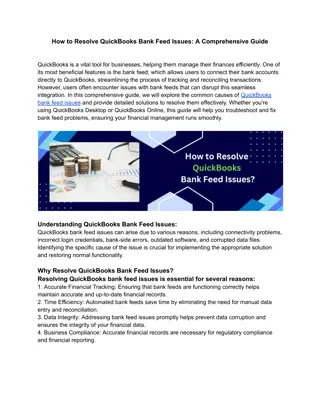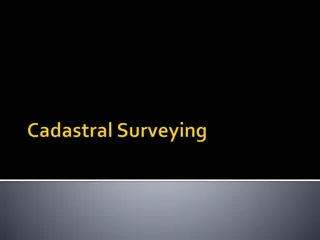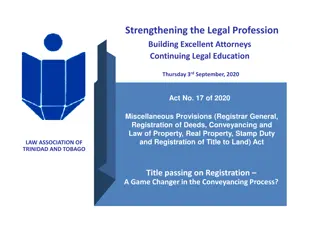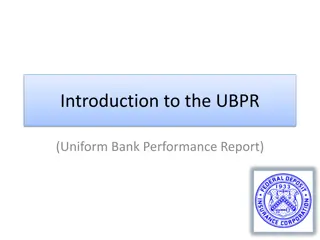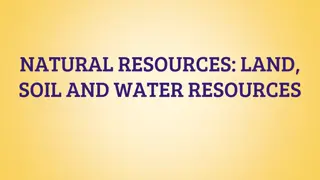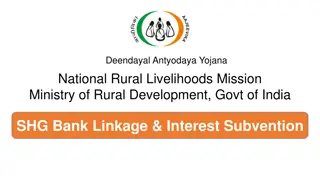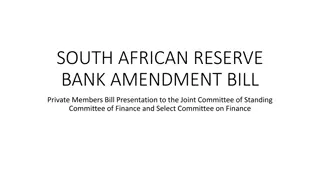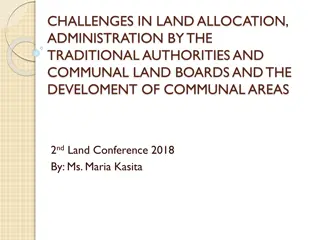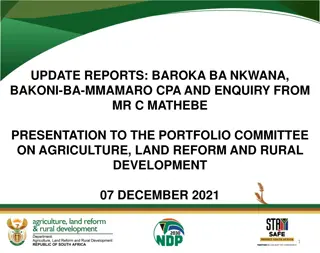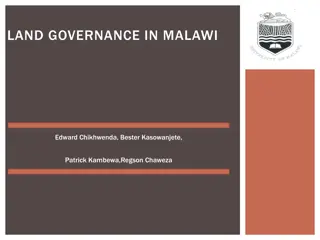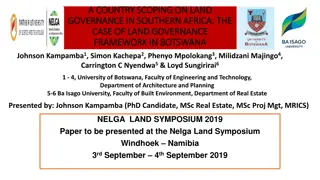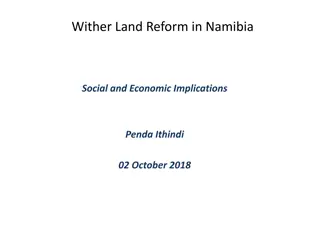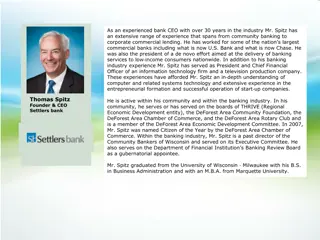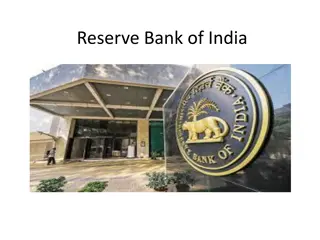Land Bank
Land Bank provided an update to the Select Committee on Finance on its progress since May 2022. The presentation covered areas such as financial sustainability, funding models, strategic overview, and progress made in addressing liabilities. Despite challenges, the Bank has shown improvements in financial discipline, stakeholder engagement, and the launch of the Blended Finance Scheme.
Download Presentation

Please find below an Image/Link to download the presentation.
The content on the website is provided AS IS for your information and personal use only. It may not be sold, licensed, or shared on other websites without obtaining consent from the author.If you encounter any issues during the download, it is possible that the publisher has removed the file from their server.
You are allowed to download the files provided on this website for personal or commercial use, subject to the condition that they are used lawfully. All files are the property of their respective owners.
The content on the website is provided AS IS for your information and personal use only. It may not be sold, licensed, or shared on other websites without obtaining consent from the author.
E N D
Presentation Transcript
Land Bank Update to Select Committee on Finance (SeCOF) 18 April 2023 Land Bank Presentation 1
Agenda 1. Overview i. ii. iii. Liability Solution update i. Key developments following the Debt Default ii. Complex process followed iii. Overview of progress Strategy overview i. Strategic intent and purpose ii. Phases and key focus areas iii. Client Value Proposition Funding model i. Historical perspective ii. Loan Book and Equity forecast iii. Principles going forward Financial sustainability i. Context ii. Group Statement of financial position iii. Way forward Conclusion and next steps Purpose of the presentation to SeCOF Progress since the previous update in May 2022 Blended Finance Progress 2. 3. 4. 5. 6. Land Bank Presentation 2 Land Bank Presentation 2
1. Land Banks Previous Engagement with SeCOF May 2022 Purpose of the Presentation Progress made since May 2022 Blended Finance Progress Land Bank Presentation 3
1.1 Purpose of the presentation to SeCOF As per the Parliamentary Programme and minutes from May 2022, Land Bank should address the following: Parliamentary Programme April 2023: 1. Select Committee on Finance Briefing by Land Bank on Quarterly Report and outstanding issues from previous engagement. 2. Land Bank to provide the Committee with an update on these issues: i. Loan funding model ii. Financial sustainability of the Bank In May 2022 the Select Committee on Finance resolved that: There is a need to discuss the funding model of the Land Bank and decide whether it should continue like that. A response is included in today s Presentation. The Bank should submit written responses to questions asked to the Committee in 10 days. A written response was timeously submitted The Committee should follow up with the Land Bank in the fourth quarter to assess progress made. It is the Purpose of this session Land Bank Presentation 4
1.2 Progress made since May 2022 Despite the unideal length of time it has taken for the Bank to conclude the Liability Solution agreement with lenders since the debt default in 2020, the Bank has continued to diligently manage its business operations: Focus Area Progress made Financial Discipline Maintained a solvent business, including the containment of operating costs. Conscientiously collected on clients scheduled loan repayments and recovered funds from defaulting customers Contained the level of Non-Performing Loans to a commendable level under difficult conditions of a significantly reduced loan book. Insourced SLA Loan Book Insourced the management of the SLA book from SLA intermediary partners, and significantly saved on SLA management fees, as well as tightened the credit management of this portfolio. Resumption of Lending activities The Blended Finance Scheme was launched in October 2022 in partnership with DALRRD. Applications to the value of R181m have been approved in support of black producers. Details to follow in later slides. A pipeline of R1.3bn has been developed to accelerate momentum into FY24. Reduced Funding Liabilities The Bank has significantly reduced its funding liabilities in line with the reduction of its loan book (45% since default), with a further repayment being currently under consideration. Stakeholder engagement The Reputation management plan has been implemented to proactively engage stakeholders Reputational risks that are being managed include the default with Lenders and collections from non-performing clients Land Bank Presentation 5
1.2 Progress made since May 2022 (continued) Area Progress made Audit outcome A significant intervention for the stabilisation of the Bank was the implementation of a rigorous remediation plan to address the credit management and internal control deficiencies that led to the Bank s Disclaimer of Audit Opinion outcome by the Auditor General in FY2020. This intervention resulted in a significant turnaround to a Clean Audit outcome in FY2022 Leadership appointment The Board is pleased to have acquired the services of our new CEO, Mr Themba Rikhotso, following the departure of the previous CEO in the first quarter of 2022. This appointment will bring the required leadership stability that is crucial for the Bank s turnaround. Organisational Capacity The Bank s headcount is 330 (300 Permanent Employees and 30 FTC employees), whilst Land Bank Insurance has a complement of 21 employees (19 Permanent Employees and 2 FTC employees). The Board continues to implement targeted employee retention strategies. Accountability and Consequence Management Progress is being made by the Board to address outstanding instances of confirmed or potential misconduct that may have contributed to the Bank s current position. In line with this prioritisation, a Board-level Accountability and Consequence Management Task Team was established to: o Assess the status of ongoing investigations o Gather data and prioritise matters with the intention of making specific recommendations to the Board and National Treasury. The deterioration of the quality of the loan book may partially be attributed to the manner in which the SLAs were concluded, managed and monitored. As such, the Board has requested that the National Treasury s Specialised Audit Services Unit conduct a forensic investigation in relation to loans that were granted and managed by the Bank s SLA partners on its behalf. Land Bank Presentation 6
1.3 Blended Finance Progress To Date Pipeline and Producer Category [As at 30 March 2023] A promising pipeline of applications and approvals is being built to ensure that the gap experienced in the current financial year is caught up in FY2024. Significant focus on building the appropriate quality of prospects and converting applications to approvals and disbursements is required. Total Funding Structure Number of Clients 114 R1,313 44 R501 R474 35 R235 19 16 R102 Initial Enquiry Initial Due Diligence Credit Total Initial Enquiry Initial Due Diligence Credit Total Assessment Review/Decision Assessment Review/Decision % of Grants Per Category % of Clients Per Category Producer Category Land Bank Loan BFS Grant Total Funding Structure Number of Clients R125 573 236 R209 001 654 R334 574 890 45 29% 39% Smallholder R445 255 431 R509 746 161 R955 001 592 67 70% 59% Medium scale R13 890 001 R9 815 600 R23 705 601 2 1% 2% Large scale R584 718 668 R728 563 415 R1 313 282 083 114 100% 100% Total Land Bank Presentation 7
1.3 Blended Finance Progress To Date Approvals (As at 30 March 2023) Approvals:Total of R181,2m made up of R90m of loans and R91,2m of grants supporting 20 clients. Disbursements: Total of R6.9m made up of R3,3m of grants and R3,6m of loans. Producer Category Producer Category Number of clients BFS Approvals (loan and Grant) % of Total Fund Size R11,3m 2% Smallholder 8 Medium Large Scale Total Approvals 11 1 20 R130,1m R39,8m R181,2m 20% 6% Commodities Livestock (Sheep, goats and cattle) R 1 Livestock (Cattle) R 1 Livestock and Grain (Maize and Soya) R 5 Pecan Nuts R 6 Grains and Livestock R 7 Grain (Maize & Soya Beans) and Livestock (Cattle and sheep) R 9 Livestock (Cattle, sheep and goats) R 10 Livestock (Cattle, sheep and goats) and Cash crops R 13 Livestock (Cattle and sheep) R 20 Sugarcane R 54 Table Grapes R 55 R0 R10 R20 R30 R40 R50 R60 Millions Land Bank Presentation 8
1.3 Blended Finance Development Effectiveness [Based on Approvals] Indicative development effectiveness based on information provided for the approved transactions. TOTAL 378 400 350 300 250 200 150 69 100 18 13 20 10 50 0 Number of BFS applications approved Permanent Jobs Created Seasonal jobs created HDI Female Beneficiaries HDI Youth Beneficiaries HDI Male Beneficiaries Number of Approved Applications Permanent Jobs Created Seasonal Jobs Created HDI Female Beneficiaries HDI Youth Beneficiaries HDI Male Beneficiaries 20 69 378 10 13 18 A Land Bank Development Indicator Framework has been developed to ensure effective reporting against Social, Environmental and Economic outcomes. A Data management project has been initiated to implement system, due diligence and monitoring tool updates, to ensure effective data collection at farm level. The reporting will be enhanced as the project progresses to incorporate all indicators approved. Land Bank Presentation 9
2. Liability Solution Update Context Progress made Potential Risks Land Bank Presentation 10
2.1 Liability Solution Key Developments following the Debt Default in April 2020 The event of default: In April 2020 Land Bank defaulted on certain payment obligations this triggered a cross default on substantially all of Land Bank s borrowings - Land Bank suspended the payment of interest and capital across all of its facilities. o Since the default the Bank has been in a de facto standstill with all its lenders (except for one lender who has since been settled) - All lenders have actively supported the Bank in its restructuring and have not called on the Bank to settle its debts and have thus far ensured that the Bank does not have to liquidate all of its assets to settle them. o In May 2020 the Bank commenced a debt restructuring process referred to as a Liability Solution to cure the event of default three versions of the Liability Solution have been considered and rejected by lenders since then. The fourth liability solution is currently being negotiated with lenders. In June 2020 R3bn equity injection by the State was announced (received in September 2020) Intended to provide a degree of financial stability to the Land Bank in order to be able to sustain its disbursements to existing customers and resume the payment of interest to Lenders. o In August 2020 the Bank paid arrear interest and resumed normal interest payments. o R7bn recapitalization announced in the February 2021 medium term budget speech. Land Bank Presentation 11
2.2 Liability Solution Complex process followed This Liability Solution entails: Extensive negotiations across the entire debt structure of the Bank which includes over 60 financiers in varying jurisdictions, instruments and maturities; and conversion into a single instrument with defined repayments. Restructuring all debts while ensuring the continued execution of the Bank s mandate and protecting the Bank from future events of default. Extensive discussions between the National Treasury, the Minister of Finance and international DFIs, taking into account potential sovereign implications. Equity transfer from National Treasury: Given the complexity of the restructuring and progress made in negotiations, coupled with improved operating and financial performance, the Shareholder transferred the remaining equity tranche to Land Bank in March 2023. To ensure that the appropriated funds are secured for the intended purpose, the funds are held in a secured and ring-fenced account such that the funds are not accessible by Land Bank or any other party until the conclusion of the Liability Solution and the fulfilment of certain conditions which will form part of the negotiations of the Solution with the lenders. Land Bank Presentation 12
2.3 Liability Solution Overview of progress since the default important achievements Capital Reduction: Since the occurrence of the event of default situation in April 2020 Land Bank has caught up and restored all interest due on funding, and in addition the following capital repayments have been made: Cumulative debt capital reduction of 45.0% (R18.1 billion as at March 23) of the original amount outstanding. o February 2021: 12% (R4.9 billion) of the then capital outstanding o June 2021: 10% (R3.4 billion) of the then capital outstanding o October 2021: 10% (R3.1 billion) of the then capital outstanding o May 2022: 19.8% (R5.8 billion) of the then capital outstanding o FY 2023: settlement of gov. guaranteed debt by National Treasury directly (R890 million) The Bank is looking to make another capital reduction which will further reduce outstanding debt. Recent developments: Good progress has been made to date regarding negotiations with lenders on the Debt Restructuring Process of Land Bank. The Bank remains solvent and liquidity remains healthy The Bank continues to support its existing customers and has resumed origination including the newly launched Blended Finance Scheme in collaboration with DALRRD. >98% of the loan book previously managed by intermediary partners known as SLAs has been successfully insourced. This has significantly improved controls around the management of this book Improved governance has provided a solid basis for restructuring Next Steps: Finalisation of Term Sheet negotiations, conclusion of agreements, and implementation of the Liability Solution to cure the default. Land Bank Presentation 13
3. Strategy overview Mandate Statement Phases and key Focus areas Client Value Proposition Land Bank Presentation 14
3.1 Re-emphasis of Mandate Statement Purpose: Land Bank is a specialist DFI that effectively balances financial sustainability and developmental outcomes to meaningfully contribute to the development and transformation of South Africa s agriculture Value proposition: Land Bank utilises financial services and products to address a critical market gap in the economy by facilitating the development and transformation of agriculture, including agricultural land ownership and use, by promoting growth of the sector and the inclusion of Historically Disadvantaged Persons in commercial agricultural. The Bank aims to provide, amongst others: Affordable finance Products to close the equity contributions and collateral gaps of new entrants in the market. Facilitation of comprehensive pre- and post-finance support programmes to improve entrepreneurial success of financed clients Facilitation of access to productive agricultural land, and production of high socio-economic impact commodities which will significantly contribute to the achievement of socio-economic outcomes. Targeted Outcomes: Inclusion of Historically Disadvantaged Persons Contribution to the GDP Job Creation and increase in the economically active population Food Security Environmental Stewardship Development Effectiveness Targets by FY28: Development Loan book to make up 50% of the portfolio 1050 New Development farmers (Estimated on average deal size of R5m Debt + R5m Grant) Number of Jobs created ESG Impact: 5% Green financing loan portfolio Note: The targeted outcomes are aligned to the objectives of the Land Bank Act, and those of the SDG s, NDP and AAMP. Financial Sustainability: Funding Model, Loan Book Quality, Revenue Diversification, Cost Management Land Bank Presentation 15
3.2 Phases and Key Focus Areas Stabilisation [FY23 - 24] Consolidation [FY25 FY27] Growth [FY27 FY32] Conclude Liability Solution Bed down Blended Finance Refinancing of debt Building a Capable Organisation: 1. Fill critical vacancies Scaling up the Growth of the Loan Book, Revenues, and Development Effectiveness 2. Finalise the Operating Model and start with Resourcing of the Organisational Structures 3. Enable delivery through identified capabilities and systems (Operating model, structure & automation, strategic partners) Funding Model: 1. Finalise Proposed Funding Model 2. Consultations with the State / Shareholder for approval and committed support 3. Implementation of new funding model * An iterative process with the Shareholder is envisaged for step1 and 2. Quality of the loan book and NPL Strategy Embedment of the land reform and eco-system role, as well as effective strategic partnering Revenue Diversification Risk Management and Governance Design Client Value Proposition Embedment of Client Value Proposition Land Bank Presentation 16
3.3 Client Value Proposition Agricultural Finance Expertise will be Land Bank s Competitive Advantage Core Value Proposition Success Factors 1. Facilitate Transformation 2. Finance Ownership and Empowerment deals 3. Enterprise Supplier Development 4. Enable Climate Adaptation and provide Disaster Relief Transaction size: Above R50m Corporate programmes to empower farmers - Structuring expertise - Financing for Equity Purchases - Network of Sector leaders Bancassurance Risk mitigation 1. Enable growth via Blended Finance 2. Increase Production Capacity 3. Facilitate Sustainable Land Access through Land Reform Programme 3. Enable Climate Adaptation and provide Disaster Relief Transaction size: R10m R50m Large farmers - Sector knowledge - Ability to implement - Funding mix Enable new entrants, including women and youth: 1. Provide affordable, long-dated finance 2. Provide pre- and post-finance technical support 3. Secure off-takes through Enterprise Development Programmes 4. Enable value chain integration through digital platforms 5. Enable Climate Adaptation and provide Disaster Relief - Lending through Provincial Network - Catalyst role through strategic partners - Appropriate Funding mix to mitigate for risk and Cost of Development - Defined Pre- and Post-finance Support Transaction size: R150k R10m (per farmer, not combined programme) Small Scale & Medium farmers Land Bank Presentation 17
4. Funding Model Historical Perspective Loan Book and Equity Forecast Funding Model Principles Land Bank Presentation 18
4.1 Historical Perspective The table below depicts the Long-Term Land Bank book in the period 1977-1980 now expressed in 2022 values (based on CPI increases). The Long-term Loan Book of R26 billion was funded through R8 billion of government capital at zero rate. Table: Long term loans Year ended December, 31 1977 R'000 1978 R'000 1979 R'000 1980 R'000 Loan indebtedness: Farmers: Long term Intermediate-term Co-operatives, control boards and statutory agricultural institutions: Long-term Total Source of funds State Capital Reserves Other Debentures Total 19 683 641 1 632 957 18 957 334 1 496 683 18 330 658 1 470 382 18 015 964 1 569 292 7 281 914 28 598 512 7 165 444 27 619 460 6 795 381 26 596 421 6 420 430 26 005 686 10 361 306 3 335 057 164 621 14 737 528 28 598 512 10 180 204 3 502 474 175 776 13 761 006 27 619 460 9 287 912 3 377 329 251 983 13 679 197 26 596 421 8 051 013 3 407 738 152 540 14 394 396 26 005 686 The Bank was effectively funded since inception to support the sector with long-dated affordable loans, disaster relief and production finance. The last 3 decades however deviated from this approach. As a result of limited capital deployment from the state, more reliance was placed on funding from capital markets. The consequence was a Land Bank with a high gearing ratio, funding miss-match and a set of lender conditions not aligned to the Bank s mandate. The above culminated in the current default position faced by the Bank. Land Bank Presentation 19
4.2 Loan Book and Equity Forecast The R3.7bn equity set aside for the Blended Finance Scheme is expected to be depleted by Q1 of FY27. Without further equity funding, post FY26, the Bank s ability to continue supporting the scheme will be curtailed. Land Bank Presentation 20
4.3 Funding Model Principles Resolving the Bank s funding model is the most important objective to enable the Bank to fulfil its mandate in a sustainable way. The Land Bank act makes provision for a number of funding sources, including state funding, to fulfil this mandate. The Balance sheet of the Bank should consist of mixed funds, to ensure an appropriate cost of funding and support for pre and post finance support that enable sustainable development finance. Problem statement The Bank cannot achieve its development effectiveness and financial sustainability with the current funding structure which is predominantly funded from the debt market. Due to the current default position, the Land Bank is unable to raise debt funding in the market. The Bank requires long-dated funding to support long term loans necessary to close the tenure gap in the market which is essential for development. The mismatch of tenure between Liabilities and Assets contributed to the Bank s liquidity challenges. The expensive cost of funding requires very high pricing to ensure Net Interest Margin. The level of cost of funding makes the Bank uncompetitive in the market. Land Bank Presentation 21
4.3 Funding Model Principles (continued) Proposed Solutions / Interventions: The Bank, supported by the Shareholder needs to review what its mostappropriate funding model should look like for it to remain financially sustainable and to ensure that it fulfils its mandate. To this effect the Bank is working on a business case and will engage and consult with all stakeholders in the process and also follow appropriate governance processes for approval and committed support. Identify and source funds (other than debt), not allocated from the State (e.g. ESD Funds and Impact Investments). Land Bank Presentation 22
4.3 Funding Model Principles (continued) Draft framework Funds Deployment Off-Balance Sheet LB Balance Sheet Pricing subsidy & technical support LB Equity Corporate programmes to empower farmers 10% Composition to ensure Bank affordability Loan component: ST, MT, LT Debt These fuds are utilised to ensure affordability at client level Sustainability funding (e.g. green and disaster relief) Pricing subsidy & technical support Large-scale farmers 20% 40% LB Equity Loan component: ST, MT, LT DFI Debt Client own contribution and pricing subsidy Small & medium scale development farmers ESD Funds Loan component: ST, MT, LT LB Equity 60% 50% Grant Off take and Technical support Land Bank Presentation 23
4. Financial Sustainability Context Group Statement of financial position Conclusion Land Bank Presentation 24
4.1 Context Land Bank has been in default since April 2020. Despite this, the Bank s stabilization efforts have yielded positive results: Since the default R18.1bn of debt has been repaid and interest payments continue to be serviced. Albeit significantly reduced, the Bank continues to support its existing customers and has resumed origination including the newly launched Blended Finance Scheme in collaboration with DALRRD. >98% of the loan book previously managed by intermediary partners known as SLAs has been successfully insourced. This has significantly improved controls around the management of this book. Some of the key challenges that the Bank is currently addressing, which impact its ability to fully operate and further impacts profitability are outlined below: The Bank is currently in the process of finalizing and agreeing the term sheet conditions with the Lenders and National Treasury which is expected to be concluded in FY24. The Bank relies mainly on collections and settlements to sustain operational activities as it is unable to raise funding at this time. This has required significant curtailment of disbursement support into the sector. The R3.7bn of the appropriated funds earmarked to support development sector funding will help. It is however not sufficient to support growth of the development portfolio beyond FY26. Land Bank Presentation 25
4.1 Context (continued) Owing to the limited funding, the Bank has seen mainly good quality customers leaving the bank for funding elsewhere. This has negatively impacted on the quality of the loan book resulting in an increase in the non performing loan ratio. The following trends have been observed since the default: o Decreasing loan book resulting in lower interest income. Origination has however been resumed. o Increasing non performing loan ratio. An NPL remediation programme has been implemented by the Bank and is starting to bear fruit. o We previously experienced a compression of Net Interest Margins, mainly due to increased cost of funds on defaulted debt. Following the debt repayment however Net Interest Margins are showing an improvement as a result of a decrease in interest payable. Some components of the loan book were sub-optimally priced at origination mainly on the long term loan book. The Bank continues to rely mainly on one revenue stream in the form of interest income. The Bank is looking into ways to diversify its revenues operating within its mandate. FY2022 Unqualified Audit Outcome (clean). This was an improvement from the Qualified Audit Opinion in FY2021 and a disclaimed audit outcome of FY2020. Land Bank Presentation 26
4.1 Context (continued) The audit outcomes of the Land Bank has significantly improved over the years as follows: FY2022 FY2020 FY2021 Unqualified with no findings (clean) Disclaimer with findings Qualified with findings A remedial plan was instituted by the board to address deficiencies identified on the loan book during the FY2020 and FY2021 financial years. The remedial plan process remains in place. The successful implementation of this plan lead to the significant improvement in the audit outcomes to a clean audit in FY2022. Land Bank Presentation 27
4.2 Current Financial Performance February 2023 YTD (Unaudited) FY2020 FY2021 FY2022 Feb 23 YTD FY2024 FY2025 FY2026 Actual Budget Rm Rm Rm Rm Rm Rm Rm Statement of Financial Performance Net interest margin 383 163 600 611 901 986 972 Impairments release/(charges) (68) (324) 1 299 406 95 271 (31) Operating expenses (704) (593) (563) (482) (877) (810) (854) Total Comprehensive income/(loss) for the year (1 584) (711) 1 391 703 252 589 217 Statement of Financial Position Cash 723 5 590 9 984 10 546 5 364 5 706 4 460 Investments 2 148 2 319 2 133 2 238 2 925 2 815 2 897 Net Loans and Advances 39 470 30 888 20 857 15 590 15 188 14 040 14 051 Total assets 44 070 40 166 34 749 30 561 22 377 21 405 20 189 Funding liabilities 41 353 36 075 29 163 23 731 10 303 8 782 7 376 Key Ratios Net interest margin 1,8% 0,4% 1,2% 2,1% 5,0% 5,0% 5,4% Cost-to-income ratio 563,6% 964,2% 79,4% 72,7% 54,7% 48,0% 49,7% Non-performing loans 23,0% 32,5% 47,7% 52,6% 53,7% 51,8% 50,8% Solvency Ratio 100,7% 106,9% 112,9% 118,1% 193,8% 212,5% 231,6% 1. Slight improvement in net interest margin in February 2023 YTD compared to FY2022 due to lower interest expense. Reducing operating expenses resulting in improved cost to income ratio. YTD profit of R703m which is lower compared to previous years. Improved cash position, decreasing loan book and funding liabilities 2. 3. 4. Land Bank Presentation 28
4.3 Feb 2023 YTD Financial Performance Overview Non Performing Loans per Channel Commentary: The insourced loan portfolio from SLA partners has a significant level of Non Performing Loans (NPL), at 60%, this has reduced from 66% in March 2022. Albeit not included in the above graph the non performing loan book has decreased from R12,3bn in March 22 to R10,3bn in Feb 23 which is attributable to the continued implementation and execution of NPL remediation strategy. Land Bank Presentation 29 * Financials are still subject to Audit verification
4.4 Financial Sustainability: Conclusions Key Focus Area Comments and Intervention Plans The Bank has experienced a significant reduction in the loan book which has a negative impact on revenue generation given the importance of interest income to the Bank s revenues. To address this the Bank has resumed lending, with the Blended Finance Scheme anchoring the loan book growth plan. Loan Book Growth The demand for funding (evidenced by applications received and approval rates) indicates that there is significant demand in the sector for financing which is being addressed through the Blended Finance Scheme. The Bank s cost of funds (which was exacerbated by the debt default interest rates) has made it challenging to provide affordable financing to the sector whilst generating sufficient margins for a sustainable portfolio. An appropriate funding model is required to resolve this challenge. o Interest Margins, and Non-Interest Income The Bank has managed to improve its Net Interest Margins through the reduction of its defaulting liabilities (and thus reduced interest expense). The Pricing Model has been reviewed and revised to ensure appropriate pricing of loans to customers while ensuring affordability. The Bank is looking into ways to diversify its revenues. The management of the loan book quality is important in Non-Performing Loans and credit losses. Quality of the loan book An NPL remediation programme has been implemented by the Bank and is starting to bear fruit. Operating Expenditure The Bank has reduced its operating expenses which has resulted into improved cost to income ratio over the last three years. Internal Management Controls The Bank s improvement in its audit outcomes over the years, to a Clean audit in FY2022, shows the level of diligence in the management of the Bank s resources and provides a fundamental prerequisite for the management of financial sustainability initiatives. Land Bank Presentation 30
6. Conclusion and Next steps Land Bank Presentation 31
6.1 Conclusion and Next Steps 1. Continued implementation of the Key Focus Areas as per the Bank s Strategic Plan. 2. Conclude the Business Case for Development effectiveness and Sustainability, which incorporates the funding model, and engage key stakeholders and the Shareholder in finalising the Business Case. Land Bank Presentation 32
420 Witch-Hazel Avenue Eco Glades, Block D, Eco Park Centurion Pretoria Land Bank Presentation 33








